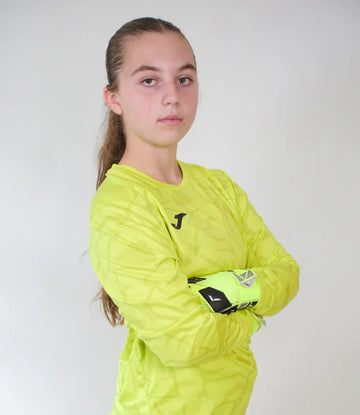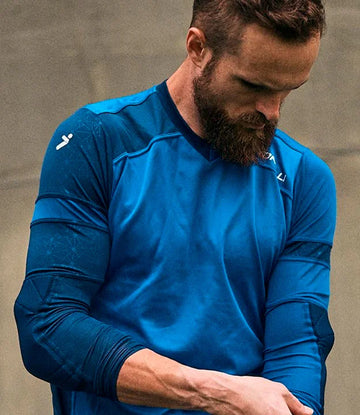Too often I see keepers camped out on their goal line while the play is going on in the other keeper’s box miles away. This leaves a giant space behind the defense for a dangerous long ball to be played. The goalkeeper is the General out on the field. The keeper needs to stay connected with the defense to communicate and organize the players. This requires a keeper to be close enough to communicate with the team and cover the space behind the defense but at the appropriate distance to not get caught by a long shot from an unpressured attacker.
Goalkeepers should take up the line between the ball and the middle of the goal and position themselves at a place off their goal line to act as a sweeper - keeper. Younger keepers, youth coaches, or keepers without footskills will not be terribly comfortable with this but it is a critical part of team defending. Goalkeepers can offer themselves as a back pass option or clear away any long through ball behind the defense if they adjust their positioning on the field based on the looming threat.
Positioning is based on ball location on the entire field.
The other 18:
If the ball is on the other side of the field around the other 18, the keeper should be at least at the top of their 18 yard box. If the keeper moves along with the play he or she is closer to the action in the event that instructions need to be shouted to defenders on marking responsibilities; to clear a ball played into space behind the defense; or offer themselves as a pass back option. When the play is on the other end of the field this is not the time to turn off and out. The keeper has to stay focused in the event of a long clearing attempt. It is important to stay loose, shake out the hands and arms, and focus on the game. This is the time to organize marks and defensive shape in the event the ball is turned over; better yet send players into support. Sometimes it is as simple as communicating and shifting the weak side center midfielder to offer more support or be in position for counter attack through the midfield.
When the play is at midfield:
As the play moves out of the defensive third you want your keeper moving to or above the penalty strip, 12 yards off the line. The keeper should be square to the attacker in possession of ball positioned properly in the correct angle. Their placement will depend on where the ball is at midfield. Why is it that we teach our keeper the importance of the correct angle during the shot save but not when the ball is out of immediate danger? Proper positioning while the ball is around midfield can help a keeper deal with through balls that lead to breakaway situations. You know the space that I referring to. The space that is halfway between the end line and the half line. Often a lofted 20 – 30 yard ball played in this area over the defense to a breaking striker causes the defense to panic leading to countless breakaway situations. If the keeper is positioned properly they may be in a better position to sprint out to deal with the danger or at least communicate with the defense to minimize the treat.
The team and keeper need to become familiar with the area behind the defense and in front of the keeper to understand who’s ball is it and when. Determining factors are the placement and speed of the attacker, pace and placement of the pass, depth of the keeper, and location of the defense. Playing higher off the keeper’s line will allow the keeper to sweep up any balls within reason and without tremendous risk. The keeper has to be exposed to these situations to understand risk verse reward and what is within their range. Playing higher also helps the keeper stay connected with their defense in order to communicate and organize.
As part of my goalkeeper instruction I instill the importance of their movement, how it helps in team defending, and concentration. Staying focused on the developing play is one of many ways to keep your pulse on the game and in proper position not to mention a defensive asset.
When the attack is in the defensive 3rd, in and around 30 yards away from the goal:
The keeper should be positioned 3 to 6 yards off the goal line depending on their comfort level and the location of the ball. A ball that is being played from around 30 - 35 yards out is of concern but should not be a real scoring threat. A diagonal pass or a chip over the top of the defense into the empty space outside or in the upper portion of the 18 is more of a reality. This is where many breakaway situations occur. Once the ball is under control the striker has a better angle to shoot the ball. If the keeper is playing higher in their comfort zone then they are in a better position to win the ball cleanly, make the decision to narrow the angle, or instruct the first defender to keep the defender outside. Breakaway situations arise much more frequently from this scenario than a chipping opportunity caused by a keeper’s poor positioning. With the ball 30-35 yards out a keeper can see when a player is unpressured and ready to chip the ball. If needed with a quick drop-step and footwork a keeper can retreat closer to their line if there is a threat of a shot. The keeper should be adjusting their positioning depending on the location of the ball and the pressure around the ball.
Will a keeper get chipped or get caught way too far out clearing a ball while working out the bugs? Sure. That is part of the educational process. The keeper and team will learn by making decisions. The keeper will learn where to be during certain situations, at what depth, with what stance, and how to deal with varying through balls. The team will learn to depend on the keeper as a critical member of the defense for a pass back option as well as a sweeper to deal with appropriate through balls.
About Keeperstop.com:
Keeperstop.com is the goalkeeper equipment and education website created by Christian Benjamin. It is a resource for the goalkeeper community to review and ask questions about goalkeeper equipment, camps, and training.






 Gloves
Gloves
 Jerseys
Jerseys
 Gear
Gear
 Brands
Brands
